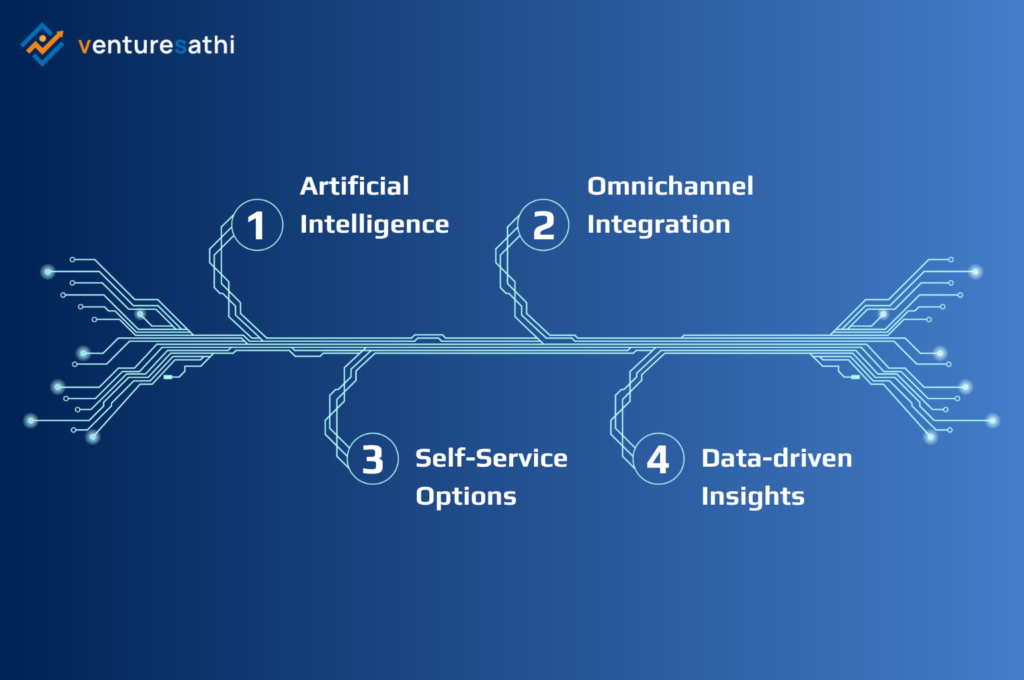In the grand scheme of running a successful business, the back office often resides in the shadows, diligently managing financial complexities and overseeing administrative functions. Yet, the significance of proficient back-office best practices cannot be overstated. They serve as the bedrock upon which organizations thrive and expand.
As your business grows and evolves, optimizing your back-office management becomes paramount. This ultimate guide delves into the seven indispensable factors that underpin effective back-office best practices. From refining processes to harnessing the latest technologies, we equip you with practical insights and strategies to elevate your back office to new heights of productivity and back office efficiency.
Whether you’re a visionary small business owner or a seasoned executive guiding a large enterprise, this guide empowers you with the knowledge and tools needed to transform your back office into a force multiplier for your organization. Join us as we unveil the secrets to achieving unparalleled back-office efficiency and productivity – the heartbeat of your success.
What are the Key Components of Back Office Operations?
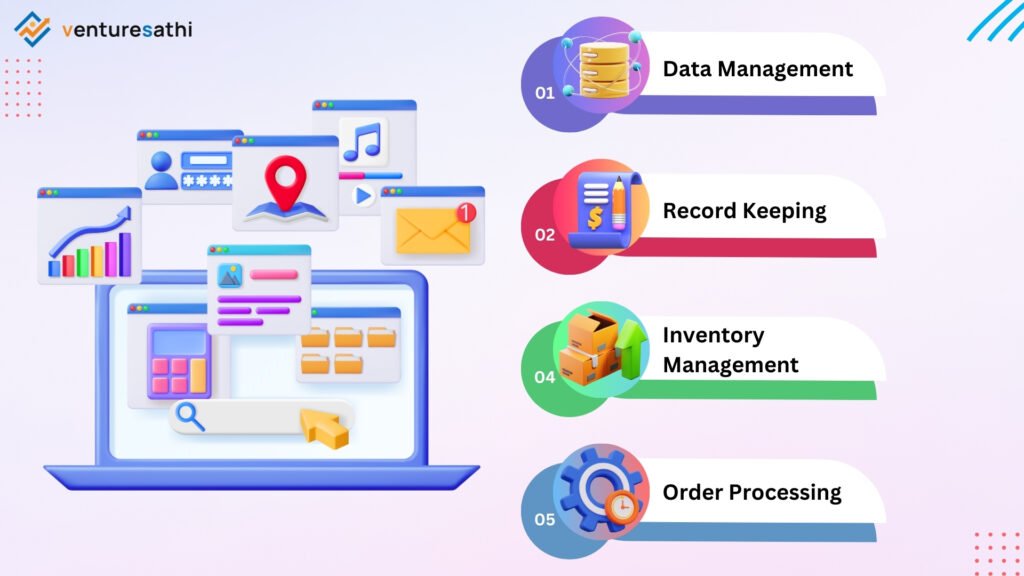
Before diving into strategies for optimizing back-office management, it’s essential to understand the core components that make up back-office operations. These include:
1. Data Management
Data management is one of the back office best practices, enabling them to analyze data patterns and gain insights into market trends and customer behavior. It ensures data integrity and security, which is critical for decision-making.
While data management may seem repetitive and boring, automating data entry and storage through digital systems not only reduces the risk of human errors but also speeds up the data analysis process increasing back-office efficiency. This is essential for data-driven decision-making and maintaining a competitive edge.
2. Record Keeping
Record keeping is another back office best practice essential for maintaining transparency and accountability. It supports the personalization of customer experiences and can be outsourced for back-office efficiency.
Efficient record-keeping enhances the ability to track customer interactions, providing valuable insights for improving products and services. By outsourcing these manual tasks, businesses can focus on core operations while ensuring records are maintained accurately and securely.
3. Inventory Management
Proper inventory management ensures that businesses have the right products available when needed, preventing overstocking or understocking issues.
Inventory management cloud accounting software streamlines the ordering and tracking of inventory. It reduces the costs associated with maintaining excess stock and minimizes the risk of product shortages, contributing to efficient supply chain management.
4. Order Processing
Order processing includes receiving and fulfilling customer requests, which is crucial for customer satisfaction. Efficient order processing can enhance the customer journey.
Automating order processing reduces the risk of inaccuracies due to human errors. It also eliminates repeated data entry, saving time and resources. Streamlining these processes not only improves customer satisfaction but also reduces operational costs while enhancing back-office efficiency.
As you delve into the core components of back office operations, consider exploring our article ‘Choosing the Right Partner for Back Office Outsourcing Services: Key Considerations‘ for insights on selecting the ideal outsourcing partner.
Understanding the Key Factors of Back Office Management
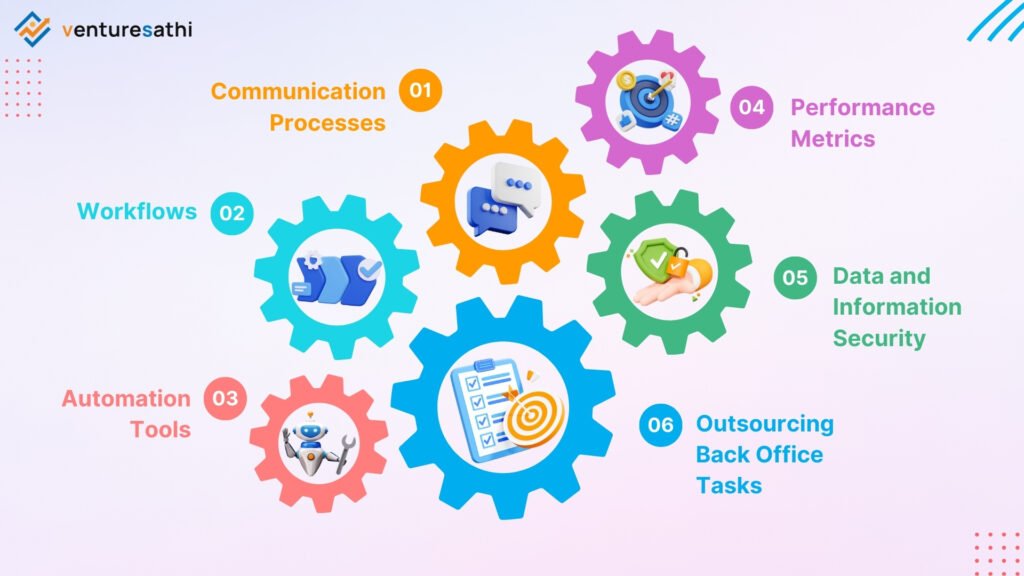
Looking to streamline your back office operations efficiently? Consider outsourcing your non-core tasks to Venturesathi. Our specialized providers can free up your internal resources and enhance the quality and efficiency of your standardized tasks. Contact Venturesathi now to learn more.
Before we embark on our journey to unlock the strategies for optimizing your back-office management, it’s imperative to grasp the foundational elements that underpin this crucial process. While each organization possesses its unique character, certain universal factors are the cornerstones of successful back-office management. These encompass:
1. Communication Processes
Effective communication ensures that all team members are on the same page and have access to the information they need. It promotes clarity and transparency in the organization.
Streamlining communication processes reduces errors and minimizes delays in standardized tasks. It fosters open and honest communication among team members, leading to improved collaboration and, ultimately, higher back-office efficiency.
2. Workflows
Well-defined workflows break down complex standardized tasks into manageable steps and assign clear roles and responsibilities, ensuring that everyone knows what is expected of them.
Streamlined workflows lead to more efficient and standardized task completion. Automation of repetitive tasks reduces the time and effort required, enhancing back-office efficiency, and reducing the likelihood of errors.
3. Automation Tools
Automation tools, such as workflow management software, cloud accounting software, and robotic process automation, streamline processes, reduce errors, and increase back office efficiency.
These tools allow for the automation of repetitive tasks to standardize tasks, saving time and resources. Automation integration into workflows enhances efficiency, making it easier to achieve goals and objectives.
4. Performance Metrics
Regular assessment of performance metrics helps identify areas for improvement and measures the effectiveness of changes.
Tracking performance metrics enables organizations to identify areas in need of improvement and make data-driven decisions. This continuous improvement approach enhances overall back office efficiency and productivity.
5. Data and Information Security
Prioritizing data and information security protects the organization from potential threats and data breaches.
Establishing data security protocols and implementing security measures reduces the risk of data breaches. Regular training ensures that all team members are aware of best practices, and safeguarding sensitive information.
6. Outsourcing Back Office Tasks
Back-office Outsourcing of non-core standardized tasks to specialized providers frees up internal resources and leverages external expertise.
Outsourcing allows organizations to focus on core business activities while benefiting from the experience of external providers. This not only reduces operational burdens but also improves the quality and efficiency of these standardized tasks.
To dive deeper into the topic of understanding the key factors of back office management, read ‘Maximizing Efficiency: The Benefits of Back Office Outsourcing‘ to see how outsourcing can optimize your processes. Contact Venturesathi for customized back-office solutions.
How to Overcome the Common Challenges in Back Office Management?
While effective back office management serves as a potent catalyst for heightened efficiency and productivity, it does not come without its share of common challenges. These hurdles may encompass:
1. Lack of Communication or Collaboration Among Team Members
Solution: Implementing centralized communication platforms, establishing clear guidelines for information sharing, and encouraging open and honest communication can address this challenge.
2. Inefficient Workflows or Processes
Solution: Identifying key processes and breaking them down into manageable steps, automating standardized tasks, and establishing clear roles and responsibilities can streamline workflows and increase efficiency.
3. Inadequate Technology or Automation Tools
Solution: Embracing cloud-based solutions and automation tools can address this challenge, improving data preparation, data intelligence, automated reporting, and data integrity.
4. Data Security Breaches or Other Security Incidents
Solution: Establishing clear security protocols, implementing security measures, and providing regular training on data security best practices can protect the organization from security incidents.
5. Difficulty Finding Qualified Talent for Back Office Roles
Solution: Training and upskilling existing team members and collaborating with educational institutions can help address talent shortages in back-office roles.
Conquering these challenges demands an unwavering commitment to your organizational goals and objectives. A continuous process of assessment and adaptation is key. Furthermore, actively soliciting input and feedback from your team members and stakeholders can unearth issues and solutions, fostering a united front toward a shared vision.
5 Major Trends Reshaping the Back Office Operations
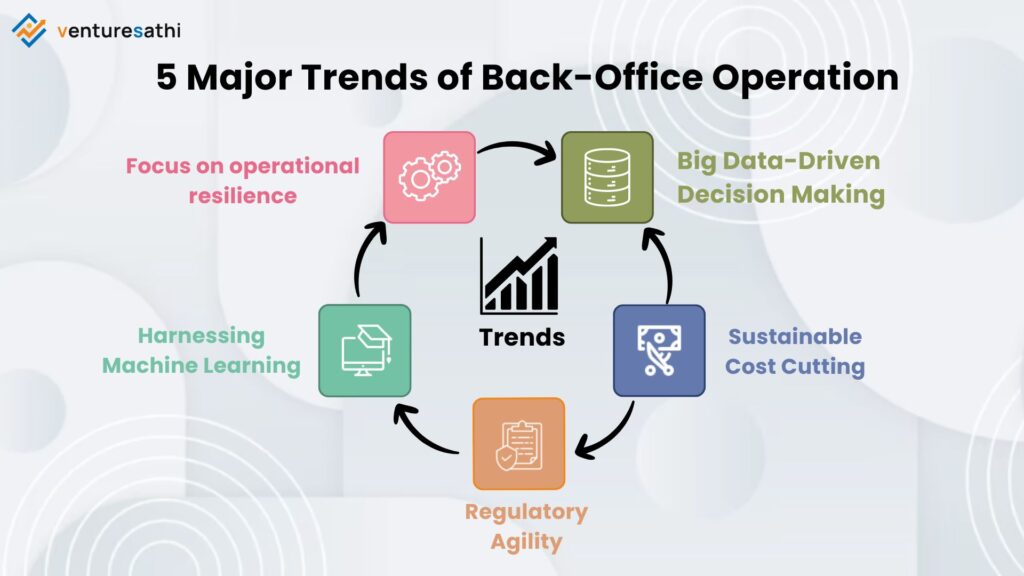
Operational leaders within banks and asset management institutions are closely monitoring and adapting to five significant trends, vital for not just survival, but thriving in the evolving landscape of the “new normal.”
Stay ahead of the evolving landscape of the ‘new normal’ by leveraging the expertise of Venturesathi. We offer tailored back-office outsourcing solutions to help you adapt to operational resilience, harness machine learning, and tackle regulatory changes. Contact Venturesathi to explore how our services can fortify your back-office operations.
1. Focus on Operational Resilience
Operational resilience is as important as financial resilience. Transitioning to flexible cloud-based systems and automating manual processes improves the ability to withstand disruptive events. Organizations that can swiftly embrace this technology will not only enhance their operational efficiency but also fortify their resilience to withstand significant disruptive events.
Cloud-based systems are accessible, scalable, and require minimal maintenance, contributing to operational resilience. Automating manual processes reduces the risk of errors and enhances efficiency, ensuring business continuity during disruptions.
2. Harnessing Machine Learning
Machine learning is already making a significant impact on financial services institutions, particularly in areas like anti-money laundering, fraud detection, and credit risk management. As per the most recent report from the Bank of England and the FCA, more than 60% of respondents have already implemented machine learning in various capacities.
Machine learning automates repetitive tasks to standardize tasks and helps in identifying data trends. This enables faster decision-making, reduces the reliance on manual work, and enhances back-office efficiency.
3. Regulatory Agility
As per the 2020 Thompson Reuters Cost of Compliance report, businesses grappled with a staggering 56,624 regulatory alerts throughout 2019, stemming from a multitude of over 1,000 regulatory bodies. This equated to an average of 217 updates every day, a significant increase from a mere ten daily updates recorded in 2004. It is no surprise that “Keeping up with regulatory change” has emerged as the foremost challenge for compliance departments in the upcoming year. Regulatory changes are on the rise, and back offices need to adapt quickly to comply with new requirements. Implementing data controls and flexible technology solutions is crucial.
Adapting to regulatory changes quickly is essential to avoid fines and penalties. Cloud-based solutions in data preparation, data intelligence, and data integrity facilitate agility in meeting regulatory requirements.
4. Sustainable Cost Cutting
The imperative to reduce expenses has become an unavoidable reality for the majority of operations departments. This necessity existed even before the pandemic, and today, some experts foresee a potential requirement to curtail costs by as much as 40%. Many organizations are under pressure to reduce costs, and intelligent technology adoption is a sustainable solution. Modernizing technology infrastructure is key to achieving cost savings.
Legacy systems and manual processes are costly and inefficient. Modern technology platforms reduce costs, enhance efficiency, and provide a scalable environment for further innovation.
5. Big Data-Driven Decision Making
The influx of data into back-office operations continues to grow. Leveraging big data for insights can provide a competitive advantage. According to the Harvard Business Review, the statistics are revealing: “On average, less than 50% of structured data is harnessed for decision-making purposes, and a minuscule less than 1% of an organization’s unstructured data is subjected to analysis or utilized in any capacity.”
Efficiently harnessing and analyzing big data enables data-driven decision-making, improving processes, and enabling better strategic choices. For instance, automating broker reconciliations and consolidating reconciliation data into a big data platform can enhance efficiency and streamline operations.
5 Simple Tips to Enhance Your Back Office Efficiency
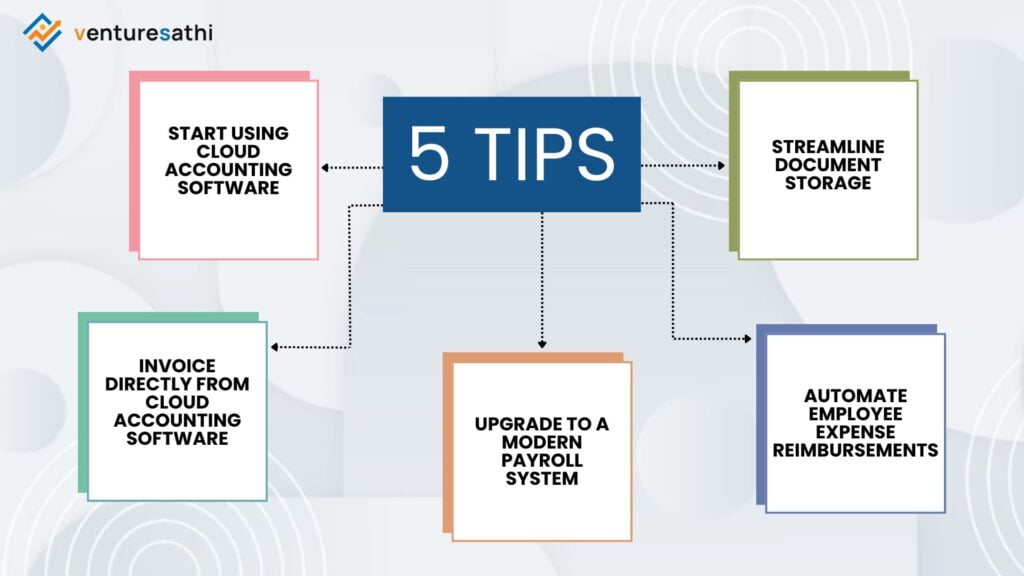
Streamlining your accounting procedures through the adoption of cloud accounting software and specialized applications represents a highly effective approach to cost reduction while concurrently enhancing the capabilities of your organization’s back office. In essence, transitioning payroll, invoicing, and other essential bookkeeping tasks to standardize tasks and online platforms liberates valuable time previously allocated to back-office management, thereby allowing you to channel those resources toward revenue-generating endeavors.
Here, we present 5 Simple yet Impactful tips designed to elevate your business’s back-office efficiency:
1. Start using a Cloud Accounting Software
Cloud accounting software, such as QuickBooks Online and Xero, offers numerous advantages. It allows for real-time synchronization of financial data, enabling you to access your accounts from anywhere with an internet connection. This capability proves especially beneficial in situations involving remote work and one of the back office best practices. Additionally, cloud accounting software can integrate with expense management tools like Receipt Bank, automating data entry and promoting a paperless bookkeeping system.
By reducing the reliance on paper documents, cloud accounting software helps prevent data loss or damage. Moreover, it ensures that critical financial information is readily accessible when needed, simplifying financial management.
2. Invoice Directly from Your Cloud Accounting Software
Generating invoices directly from your cloud accounting software provides several benefits. It enables you to maintain brand consistency in your documents by incorporating logos, fonts, and colors. Moreover, it centralizes customer data, facilitating an organized audit trail.
Automating the invoice generation process streamlines the sales process, reduces the likelihood of errors, and accelerates the payment cycle. This leads to more efficient cash flow management and a better customer experience.
3. Upgrade to a Modern Payroll System
Modern payroll systems like Payworks and Rise offer a host of advantages, upgrading to a modern payroll system is the back office best practice as they provide real-time visibility into employee records, ensuring that you can access accurate information whenever needed. Furthermore, these systems facilitate a clear audit trail and make it easy for employees to access their pay stubs. They also simplify the generation of important documents like T4s and ROEs.
Managing payroll manually can be error-prone and time-consuming. Modern payroll systems significantly reduce the likelihood of errors and save time, making the process more efficient. This ensures that employees are paid accurately and on time, contributing to overall satisfaction.
4. Automate Employee Expense Reimbursements
Tools like Expensify simplify the process of tracking employee expenses. Employees can easily capture photos of their expense receipts and upload them to the system. This eliminates the need for paper receipts and vouchers promotes a paperless approach to expense management and proves to be a back-office best practice. Additionally, these tools can integrate with cloud accounting software to further streamline the process.
Automating expense reimbursements not only saves time but also reduces the chances of errors. It allows for more accurate and timely reimbursements, enhancing employee satisfaction and minimizing administrative burdens.
5. Streamline Document Storage
Going paperless with apps like Receipt Bank or Hubdoc is the back-office best practice. It simplifies the storage and retrieval of important documents, reducing clutter and making it easier to organize and access data. This is particularly beneficial for year-end audits and ensures the safety and integrity of financial records.
Eliminating the need for physical documents not only saves on paper and toner costs but also increases efficiency by reducing the time spent searching for and managing paper documents. It also ensures that financial data is well-organized and easily accessible when needed.
Efficient back office management stands as a linchpin for achieving peak efficiency and productivity within any organization. It is through a meticulous focus on pivotal factors, including refined communication processes, streamlined workflows, judicious automation tools, stringent performance metrics, unwavering data and information security, strategic outsourcing, and adeptly tackling common challenges, that one can truly optimize their back office operations and pave the path to resounding success.
Whether you find yourself at the helm of a nimble small business or are a seasoned executive steering a large enterprise, these proven strategies and invaluable tips serve as the compass guiding you toward the pinnacle of back-office management. The time for action is now; embark on the journey to unlock newfound efficiency and productivity in your organization’s back office.
By adopting these forward-thinking practices and harnessing the capabilities of modern technologies, you not only streamline your processes but also mitigate the risk of costly errors. This, in turn, leads to substantial cost savings and an overarching enhancement of your organization’s bottom line. Remember, in today’s fiercely competitive business landscape, effective back-office management is the cornerstone of triumph.
Ready to optimize your back office management and boost your organization’s bottom line? Venturesathi can assist you in transitioning to cloud accounting software, automating processes, and enhancing efficiency. Contact Venturesathi for a free consultation to explore how we can elevate your back office to new heights of productivity.


